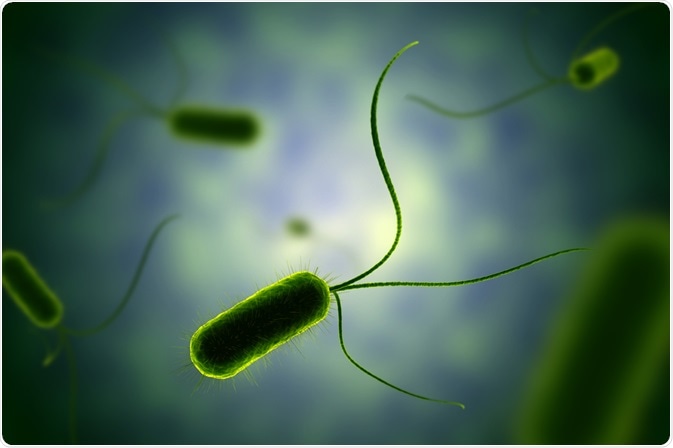Bacteria are able to translocate by a variety of mechanisms, independently or in combination, utilizing flagella or filopodia to swim, by amoeboid movement, or by gliding, twitching, or swarming. They generally move along a gradient, towards or away from nutrients or toxins, with respect to any of the many parameters they are capable of sensing: chemical, temperature, light, electric fields, magnetism, gravity, rigidity of surrounding cells, frequency of cell adhesion sites, etc.
 Image Credit: Shawn Hempel/Shutterstock.com
Image Credit: Shawn Hempel/Shutterstock.com
Methods of motility
Flagella allow movement across solid surfaces and through liquid environments, though movement through these distinct environments may be facilitated by separate sets of flagella or necessitate cell morphology changes.
Flagella are particularly useful to bacteria in allowing comparatively rapid movement away from toxins in quickly changing environments, with membrane-bound environmental chemoreceptors forwarding a signal through a two-component phosphorelay system to the flagellar motor.
Depending on the phosphorylation state of this system the flagella rotate in a clockwise or counterclockwise manner, with the latter resulting in the formation of a flagella bundle at one pole of the bacterium that acts as a propeller to push the cell forwards.
In the absence of a chemical attractant, or in the presence of a repellent, the regulator becomes phosphorylated and changes the rotation clockwise, disrupting the bundle and causing the cell to tumble and rotate in position. Random reorientation and reactivation of counterclockwise rotation of the flagella following the tumble then result in a change in direction towards the attractant or away from the repellent.
Besides reaching the preferred site of infection, flagella-mediated motility plays a role in adherence, biofilm formation, and immune modulation, with flagellin (the protein that constitutes the flagellum) being a favored target for neutralizing antibodies and other immune biomolecules.
Twitching and gliding motility is facilitated by type-IV pili (T4P), which reach, anchor, and pull the bacteria across solid surfaces. Since this can occur in either a jerking or smooth motion, the terms twitching and gliding were applied, though some cells are able to smoothly traverse solid surfaces without T4P, and so gliding now generally refers to other rarer motility methods.
T4P machinery is also involved in the movement of virulence effector proteins into host cells and the mediation of DNA uptake and transfer, contributing to the spread of antibiotic resistance to neighboring bacteria.
Motility inhibition
The quantity of molecular machinery working in unison to allow directed movement in bacteria provides ample opportunity for drug interference, both directly by inhibiting function or by blocking the synthesis of motility structures. Several drugs of this type have been found that inhibit bacterial motility very well in vitro.
For example, quinazoline-2,4-diamino analogs inhibit the sodium ion driven flagellar motor of Vibrio cholerae, preventing their functioning directly, while other compounds may aim to mimic the attractant or repellent and force the bacteria into a constantly moving or tumbling state. Drugs that interfere with flagellar assembly at the gene expression, posttranslational, or protein export system levels have been considered, and though there are some concerns regarding off-target effects in humans, these drugs have proven effective in the lab.
Quorum sensing and the formation of biofilms play a key role initiating swarming or swimming behavior in bacteria, therefore disrupting the chemical signaling between them can also inhibit motility. Bacteria can tune surface wetness and surface tension of their medium by secretion of surfactants, which can be disrupted by fatty acids. P. aeruginosa motility was completely inhibited by 12-methyltetradecanoic acid at 41 μM in this way, while bacterial growth was unaffected.
Inhibiting bacterial motility does not reduce the pathogenicity of an organism, but merely drastically lowers its ability to spread and escape toxic environments. It can be assumed that resistance mechanisms will develop against any drugs aimed at reducing motility, as the organisms under selection pressure towards resistance are not also being destroyed by the drugs. Therefore, the future of bacterial motility inhibitors may be as a combination drug, intended to work synergistically with other antibiotics.
References:
Further Reading